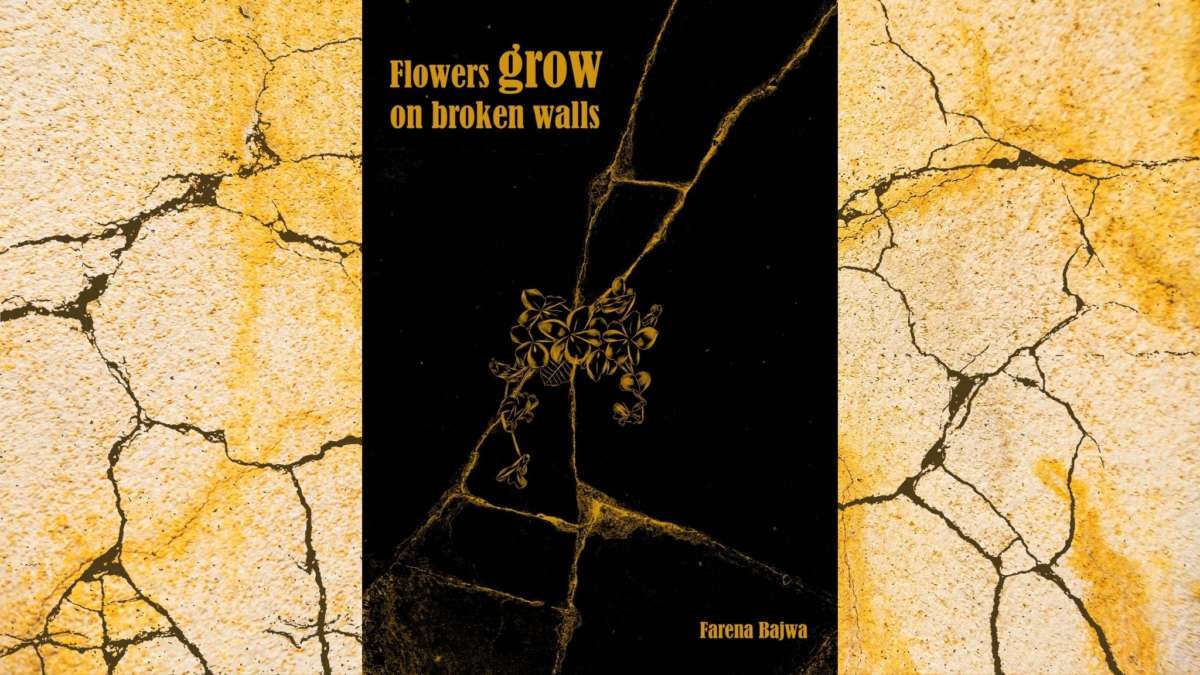Flowers Grow on Broken Walls
It doesn’t take long in this life before you realize that you need to protect yourself from the world. Some people are able to set and maintain healthy boundaries without guilt or remorse, while others build walls that become their prison as well as their shield. While boundaries bend and flex, walls do not, and so they are prone to falling apart under the slings and arrows of anger, judgment, rejection, indifference.
Farena Bajwa describes the fallout of a particularly traumatic breakup: “I built up walls around my heart / and that’s what got me killed.” We pick up the pieces of the shattered self. They won’t fit back together in the same way anymore. When you can let go of who you were, you can become who you were meant to be. Or as Bajwa writes: “Even rocks have cracks. / That’s how you find the gold.”
Flowers Grow on Broken Walls is Bajwa’s illustrated journey through heartbreak, loneliness, self-doubt and ultimately, healing. In it, she probes the shattered pieces of the self, exploring and repositioning them in evolving ways through the healing power of poetry.
A FILMMAKERS’ APPROACH
We meet our storyteller at “The End,” where “it all starts” — the moment of giving up hope on a relationship, the moment of letting go. But it’s never that easy. “I am trapped in a loop of memories,” she writes, and then shortly afterward: “That’s it. / I am putting on my shoes, / I will walk all the way back to the start, / and I will change the ending.” But then on the next page: “I am taking a train to no destination. / Now I can’t get off; it moves too fast.” In this way, Bajwa carefully constructs the order of her poetry. The poems are untitled, and some are positioned deliberately in a particular way on the page; sometimes it isn’t clear where one poem ends and the other begins.
But perhaps that is the point. One of Bajwa’s many artistic mediums is filmmaking, and her visual treatment of her verse seems to reflect this: a sequence of scenes that quietly build a storyline, fading or jump-cutting to the next, depending on the effect desired. There are even “interstitial titles” in the book, dividing it into thematic sections. And of course, the many pen-and-ink illustrations that add depth to the words, an additional layer of metaphor, or sometimes a “punchline” to the poems they accompany, such as this one: “I am a princess dancing with you amidst shades of green / until the singing of the birds turns into unpleasant ringing.” Among the accompanying images? An alarm clock.
There are many topics addressed under the book’s overarching theme: anxiety and panic, the shadow self, the vulnerability of art, pressures of social media, God’s grace, enjoying life’s journey, self-acceptance. Of the latter, Bajwa writes: “No one has my eyes / no one has my lips / no one has my ears / & / no one has my nose / since no one has my face, / I am calling it / perfect / as it is.” And then, later on, picking up the theme again: “Does the woman on that magazine / look more beautiful than me? / I don’t think so. / I think she looks more different than me.” Yes, ladies. Take a moment to think on that one. I did, with gratitude.
FROM SELF TO ART TO SELF AGAIN
Some of the strongest poems in the collection contemplate art, myth and history, such as one about a painting of Calypso and Odysseus, which leaves the viewer wondering “… whom to / feel sorry for; the man who was kept for / seven years until his liberation, / or the nymph who suffered from then on / until eternity.” Or this one about Roman gladiators: “A gladiator had to fight only once or three times a year. / He was well provided for the rest of the time / … Living a life with death always one step behind. / … Maybe knowing the next battle could be the last / made them confident and honor life. / They celebrated every victory, be it small or big.” Regardless of the subject matter, such poems find their resonance among the more personal ones that surround them, reflecting back the same themes from different perspectives and with new insights.
Flowers Grow on Broken Walls is the kind of art that can help us process the pain and trauma in our own lives. Through it, we learn that it’s okay if we can’t glue our pieces back together seamlessly. The cracks in our walls are not a weakness but a source of nourishment for beauty to take root. Nothing that we are is wrong, just different. But also evolving. Change is in our nature. Or as Bajwa puts it: “We all live more than one life. / We are humans. / We have too much to offer / to live only one.”
Learn more about Farena Bajwa on her BookTrib author profile page.






